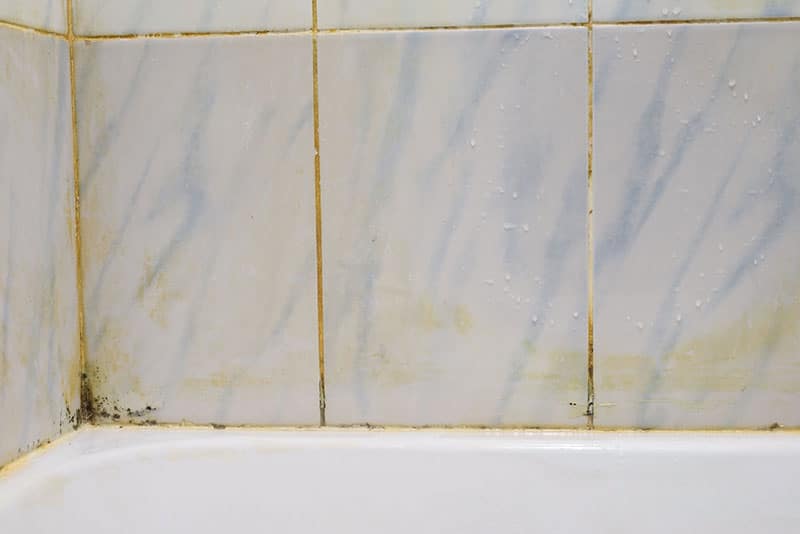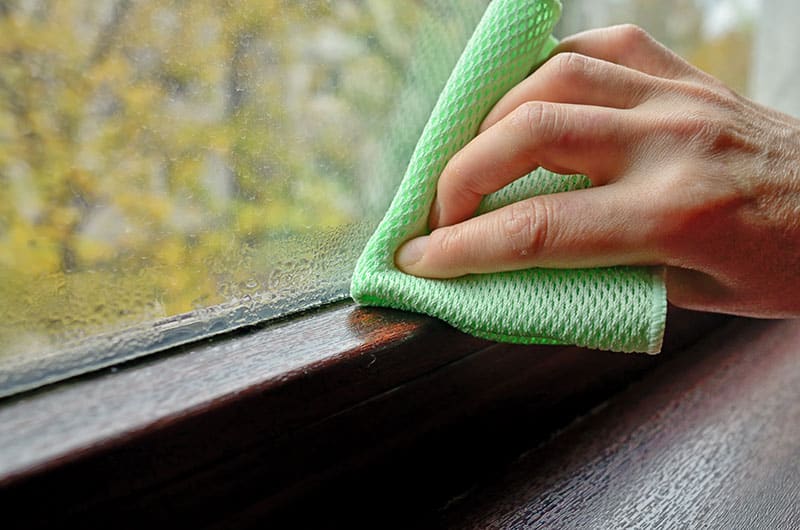We've independently reviewed this article to make sure it's as accurate as we can make it.
To find out more about our article creation and review process, check out our editorial guidelines.
Are you wondering how long mold takes to grow?
You’re not alone! I know how concerning mold can be, as it can pose a health risk.
Luckily, in this article, you’ll learn all there is to know about mold growth, including effective prevention methods.
Mold takes between 24 and 48 hours to grow after water has been left on a surface. If the conditions for mold growth persist, it can quickly escalate into a more significant problem within a couple of weeks. Mold spores are usually visible after 18-24 days.
Keep reading to learn more about the mold growth timeline!
How Long Does It Take for Mold to Grow?
How fast can mold grow? Well, it depends.
Mold growth and spread will vary depending on the specific location, the presence of moisture, and other related conditions.
Disclaimer – This article is focused on cleaning green or white mold. If you’re dealing with brown or black mold, don’t attempt to remove it as you can make the mold spores airborne. Instead, it is worth calling a professional to take care of mold with specialist equipment.
Remember, exposure to mold can lead to different health issues, such as allergic reactions and shortness of breath. Keep in mind that long-term exposure to certain types of mold can lead to more serious conditions.
To help you estimate the speed of mold growth, I prepared the following table:
| Location of the Mold | How Long It Takes for the Mold to Grow | How Long It Takes for the Mold Spores to Become Visible |
| Hidden Surfaces | 24 to 48 hours | 24 hours |
| Hard Surfaces | 24 to 48 hours | 14 to 21 days |
| Attic | 24 to 48 hours | 24 hours |
| Wet and Warm Areas | 24 to 48 hours | 24 hours |
| Open Areas | 24 to 48 hours | 30 days or more |
Identifying and Preventing Mold in 4 Common Areas of Your Home
Now that you know how fast mold grows, it’s time for us to discuss the rooms mold is most likely to affect.
Keep in mind that moisture, warmth, and darkness are the ideal conditions for mold spores to spread.
This guide will also give you some simple solutions to help prevent mold build-up in your home.
#1 The Bathroom
It is common for mold to grow around the shower and bathtub, under the sink, on the walls and floor, and behind the toilet.
In my experience, even a minor leak in the pipes beneath the bathroom sink can attract mold. Also, mold can develop if cleaning equipment isn’t dried properly before it is stored under the sink.
Keep in mind that mold can also find its way between tile grouting on the floor and wall, around the shower and bathtub.

Luckily, you can easily prevent mold from appearing in your bathroom by fixing leaking faucets and pipes, drying surfaces after cleaning them (such as the floor after mopping), and installing an extractor fan.
For a more reliable fix, you can also paint the bathroom with mold-resistant paint, as it has a moldicide that reduces mold growth.
#2 The Kitchen
From what I’ve seen, mold can easily grow in kitchens.
You see, kitchens have different surfaces, which can be warm and wet, such as the area near the sink, making it easy for mold to grow.
It is common for mold to grow in the kitchen under or around the sink, refrigerator, or microwave.
You see, mold can quickly spread around the sink because it is always damp, and spores usually begin to grow in the place where you leave your wet sponge. Mold is also likely to form under, around, and on your drying rack.
Food that has passed its use-by date gives mold the chance to grow. Mold can quickly spread, even if the food is kept inside the fridge or freezer or left out in the open.
Don’t worry, though. You can easily avoid mold growth in your kitchen by fixing leaking faucets and pipes, drying countertops after cleaning them, and removing old food from the refrigerator. Cleaning spills in the microwave immediately, drying the dishes, and installing an extractor hood can also prevent mold formation.
#3 The Bedroom
Unfortunately, mold can also grow in your bedroom due to condensation.
You see, condensation is caused when humid air meets a cold surface like your windows. To prevent mold growth, please clear condensation off the windows.

You can also prevent mold growth in your bedroom by repairing leaks in the air conditioning. I also recommend using a bed frame with slats to air the mattress and ventilate the room regularly.
If you have single-glazed windows, replacing them with double paned glass works great because it insulates the warm, moist air in the home from the cold glass on the outside. This prevents the inner glass from becoming cold and forming condensation – which leads to mold.
#4 The Attic
I find mold spores appear faster in attics and insulation than anywhere else in the house.
To prevent mold growth, please ensure your attic vents are functioning properly. Generally, gutter clogs will not cause moisture in an attic because they should be the lowest point on the roof, but these are still worth clearing.
Clogged gutters will rot out the fascia boards and soffits if made from wood and not protected by cladding or paint.
How to Clean Mold Patches: 6 Simple Steps
Mold spreads quickly. So if you’ve found a patch of mold in your home, you’ll need to clean it immediately. Ensure you get rid of it ASAP before it becomes a bigger problem!
If the patch of mold isn’t too big, you should be able to tackle it yourself without calling in a professional. Here’s a method for cleaning mold that will help keep you and your family safe.
You will need:
- Gloves
- Protective eyewear
- A mask
- Disinfectants specifically designed to kill mold, such as bleach
Method:
- Put on the protective gear: gloves, eyewear, and mask.
- Ventilate the area. Keep the windows and doors open while you are cleaning.
- Conduct a test patch. Clean a small area that has been affected by mold. Remember, when mold growth is extensive, it’s best to call a professional.
- Clean all surfaces with a disinfectant. Let the solution rest on the surface for 10 to 15 minutes before rinsing it with hot water. You’ll need to remove the mold with a stiff brush for hard surfaces. But, for porous materials, please use a sponge. You can also mix a small amount of bleach with water to kill white or green mold (as long as you can smell the bleach, there’s enough there).
- Dry the surface thoroughly. Keep an eye on porous surfaces. If mold resurfaces after a few days, discard the item and seek professional help.
- Keep the area ventilated after cleaning to ensure mold spores clear the atmosphere.
Wrapping Up: Key Takeaways on Mold Growth Time and Prevention
Hopefully, now you know how fast mold can grow and different ways to prevent it.
Remember, mold grows quickly and spreads fast. It can easily appear in your bathroom, bedroom, kitchen, and other rooms in the house.
To prevent mold growth, don’t forget to fix any leaks, remove old food from the refrigerator, regularly clean your home, and dry surfaces thoroughly.
If this article has been helpful to you, then why not check out some of our other articles and free guides? You could also sign up to join our email list!
Have a great day!
-Craig








